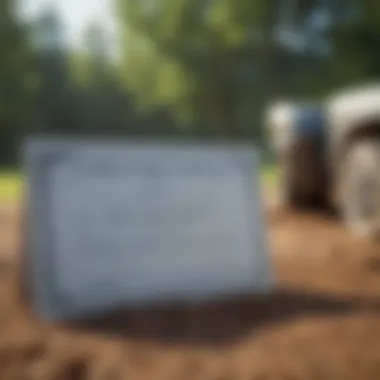Understanding Social Security Disability Burial Benefits


Intro
When it comes to end-of-life planning, many people often overlook the financial implications associated with burial expenses. This necessity becomes even more pressing for individuals who rely on Social Security Disability benefits. Understanding the burial benefits associated with Social Security can provide essential peace of mind and clarity for both recipients and their families. While the concept may sound straightforward, the nuances of eligibility, the application process, and financial impact can leaves many scratching their heads.
The aim of this guide is to shed light on Social Security Disability Burial Benefits, breaking down not only the mechanics of these financial aids, but also highlighting why they are crucial for planning during life's most challenging times. By covering the key points meticulously, we’ll address any prevailing misunderstandings, unravel the processes, and perhaps even shift perspectives on what it means to plan for the unforeseen.
Key Definitions
Navigating the world of Social Security Disability Burial Benefits starts with grasping a few fundamental terms that often get tossed around but rarely explained thoroughly. Understanding these can make a world of difference down the line.
Essential Financial Terms
- Burial Benefit: This is a one-time payment to help cover burial expenses for eligible individuals who have been receiving Social Security Disability benefits. The amount can vary based on specific criteria related to the deceased's circumstances.
- Eligibility: Generally refers to the criteria that a beneficiary must meet to qualify for burial benefits. This can include income limits, disability status, and the relationship to the deceased.
- Survivor Benefits: These benefits are paid to the surviving family members of a deceased individual who had earned enough work credits through Social Security, including those on disability. It’s crucial for families to understand how this intersects with burial benefits.
Terminology Breakdown
- Social Security Number (SSN): This number is essential for navigating benefits, as it ties all records to the individual’s contributions and eligibility status.
- Death Certificate: A vital document required during the application process for burial benefits. It serves as proof of death and is often needed in various financial and legal dealings.
- Application Process: Refers to the steps necessary to secure burial benefits, which can include forms, documentation, and possible interviews.
By demystifying these terms, individuals can begin to understand and appreciate the framework of Social Security Disability Burial Benefits. This familiarity is the first step toward informed decision-making for both themselves and their loved ones.
Preface to Social Security Disability Benefits
Understanding the framework surrounding Social Security Disability benefits is foundational for countless individuals navigating the complex landscape of end-of-life arrangements. These benefits, designed to provide financial assistance to those unable to work due to disabilities, extend beyond daily living expenses; they also touch on the somber topic of burial benefits. It’s crucial to grasp not only the mechanics of these benefits but also their significance for both recipients and their families.
Overview of Social Security Disability
Social Security Disability Insurance (SSDI) is a federal program intended to support those who can no longer sustain employment owing to a disabling condition. This program allows eligible individuals to receive monthly payments, thus ensuring some financial stability amid a challenging time. The criteria for qualifying include work history and the seriousness of the disability, both of which are assessed by the Social Security Administration (SSA).
To qualify, the individual must have garnered enough work credits, which are earned through paying Social Security taxes. While each case is unique, the basis remains that if someone has contributed sufficiently to the Social Security system and is subsequently found to be disabled by SSA standards, they can access these critical benefits.
Importance of Burial Benefits
Burial benefits, often overshadowed by the more prominent aspects of SSDI, hold significant weight for individuals planning their financial future. They provide a means to cover funeral and related costs, which can be a notorious financial burden for families. This is not just about alleviating costs but also about honors and a dignified farewell. By understanding these benefits, families can prepare for the inevitable, ensuring that their loved ones are not left facing monumental expenses during a period of grief.
"Proper planning for burial expenses diminishes the emotional and financial stress surviving family members endure."
Providing burial benefits illustrates how the safety net of SSDI extends into aspects of life and death, an often uncomfortable but necessary topic to address. This section lays a foundation for the understanding of burial benefits, transitioning seamlessly into the eligibility criteria that follow. In doing so, we pave the way for informed discussions around application processes and financial implications, ultimately enhancing preparedness for families navigating through such transitional periods.
Eligibility Criteria for Burial Benefits
Understanding the eligibility requirements for burial benefits under Social Security Disability is crucial for recipients and their families. These criteria not only dictate who can access the benefits but also shape the overall financial planning process after the death of a disability recipient. As families face often stressful times needing to manage various aspects of their loved one's passing, being clear on these eligibility rules can make a significant difference.
General Eligibility Requirements
To qualify for burial benefits, an individual must meet several key criteria set out by the Social Security Administration (SSA). Here’s a breakdown:
- Disability Status: The applicant must have been receiving Social Security Disability Insurance (SSDI) payments at the time of death. This proves eligibility as these benefits are specifically designed for those who can no longer work due to a disability.
- Sufficient Work Credits: A deceased individual needs to have earned enough work credits through their employment history. These credits reflect the number of years worked and the amount earned, tying directly to the individual’s eligibility for benefits. Usually, 40 credits are necessary for full benefits, but younger individuals may qualify with fewer credits.
- Death Verification: A death certificate or notice is required to process the burial benefit claim. This document serves as proof, affirming the passing of the individual entitled to benefits.
It’s also important for families to be aware that not all burial expenses are covered. The SSA has a specific limit on the amount they provide, which can sometimes leave families needing additional funds to cover the full cost of the burial.
Specific Conditions for Disability Recipients
Let’s get down to some specifics here. Not every condition qualifies someone for disability benefits. The SSA has a precise listing known commonly as the Blue Book, which details medically recognized disabilities.
- Qualifying Conditions: Some examples of conditions that often meet the criteria include chronic respiratory disorders, severe mental health issues, and certain types of cancer. A medical professional's documentation is critical to substantiate such conditions.
- Duration of Disability: The claimant must demonstrate that their condition is expected to last at least one year or result in death. This expectation significantly influences eligibility, as short-term disabilities do not meet the requirements for flare-ups or temporary illnesses.
It’s not just about having a diagnosis; it’s the holistic view of the disability's impact on daily living and survival, too.
Residency and Citizenship Requirements
The SSA also has federal regulations regarding residency and citizenship, which plays an important role in determining eligibility for burial benefits.


- U.S. Citizenship: Generally, the deceased must be a U.S. citizen or a qualified alien. This status ensures that benefits are reserved for those who have legally resided in the country.
- Residency Requirements: The individual should have lived in the United States for a certain period immediately preceding the claim for burial benefits. This typically translates to being physically present as a resident or meeting specific employment-based residency qualifications.
Understanding these requirements can significantly impact families trying to navigate the complexities of Social Security Disability burial benefits while grappling with the emotional toll of losing a loved one.
Being informed about eligibility criteria for burial benefits can ease the financial burden on your family during an already difficult time.
Application Process for Burial Benefits
Navigating the application process for Social Security Disability burial benefits can feel as daunting as trying to find a needle in a haystack. However, understanding each step can illuminate the path, helping families secure the financial assistance needed during a difficult time. This section dives into the nuts and bolts, offering clarity on how to initiate the application, the supporting documents required, and what to expect in terms of timing.
How to Apply for Burial Benefits
The initial step in this journey is to actually apply for the burial benefits. This might sound simple, but it requires careful attention to detail. Typically, the application can be completed online through the Social Security Administration's (SSA) website, or families can opt to apply in person through their local SSA office. Here are the steps in a nutshell:
- Gather Information: Collect vital information about the deceased, including their Social Security number, date of birth, and details regarding any funeral homes used.
- Submit the Application: Fill out Form SSA-8, which pertains specifically to burial benefits. Ensuring all sections are filled out accurately will prevent delays.
- Follow Up: After submitting, it’s wise to follow up. Being proactive can speed up the process and avert potential issues.
Many think this part is straightforward, but keeping track of everything is key. Small errors can lead to significant delays.
Required Documentation
Documentation is a critical aspect that can often trip people up. When applying for burial benefits, certain documents need to be prepared. Appropriately compiling these can make the application process go much more smoothly. Below is a checklist of typical documents needed:
- Death Certificate: Official documentation confirming the death of the individual.
- Proof of Funeral Expenses: Invoices or receipts showing how much was spent on funeral services.
- Social Security Number: The deceased's Social Security number is essential.
- Personal Identification: Valid identification of the person handling the application, usually a family member.
Having these documents readily available can prevent unnecessary back and forth with the SSA. Not only does it streamline the process, but it also eases some stress for grieving families.
Navigating the Application Timeline
Ah, the question of time: how long does this all take? Generally, the application for burial benefits is processed relatively quickly, assuming all documentation is in order. Families should be prepared for a timeline that could stretch from a couple of weeks to several months, depending on various factors. To set realistic expectations:
- Initial Processing: Roughly 10 to 15 days for the SSA to verify documentation after submission.
- Final Decision: Once verified, families can typically expect a decision within another 30 days.
- Receive Benefits: If approved, the benefits are usually issued within a few weeks after that.
"The hardest part is often simply starting the process. Once you get the ball rolling, things tend to fall into place."
In summary, while the application process for Social Security Disability burial benefits involves several steps and attention to detail, it is designed to provide essential support during an emotionally charged time. By preparing adequately and understanding the requirements, families can navigate it more effectively, ultimately providing some peace of mind in a challenging situation.
Financial Aspects of Burial Benefits
Understanding the financial facets of burial benefits is paramount for anyone navigating the complex world of Social Security Disability. Beyond their purpose of covering final expenses, these benefits can significantly influence the financial health of surviving family members. Grasping aspects like benefit amounts, estate implications, and tax considerations can help individuals make knowledgeable decisions. This information is not just about dollars and cents; it's about managing legacies and ensuring peace of mind during trying times.
Benefit Amounts and Limits
To put it plainly, the burial benefits provided by Social Security are intended to ease the financial burden of funerals. As of now, the maximum amount that can be paid out for burial expenses is set at $255. This figure, while may seem a bit on the lean side, can be a vital lifeline. In some circumstances, additional funds may be available through other programs, but it’s crucial to plan accordingly.
The key takeaways regarding burial benefits include:
- Flat Rate: A determined rate from Social Security.
- Application Criteria: Not everyone may claim these benefits, depending on the recipient's standing with Social Security.
- Supplementary Assistance: Other avenues might provide added financial support.
The importance of understanding these limits cannot be overstated because they influence how families prepare for the inevitable. With prices for funerals often behind projections, individuals should not bank solely on these benefits to cover all their expenses.
Implications for Estate Management
When it comes to managing estates, burial benefits can absolutely change the game. Families must be astute about how these benefits fit into the larger financial picture. For one, individuals receiving disability benefits might have changes in their estate planning prompted by burial considerations.
- Asset Management: Knowing that those burial funds exist creates a need to reassess how assets will be allocated. If a family is counting on this payment, other funds might not need to be set aside.
- Burial vs. Other Expenses: Sometimes, individuals end up spending on memorial services that exceed what benefits cover. Balancing priorities between memorialization and conservation of wealth is crucial here.
- Cash Flow Planning: Families should contemplate the timing of expenses and fund availability, integrating this aspect into their financial strategy.
In essence, being aware of how burial benefits interact with estate finances provides families the ability to make well-informed choices and proactively address future needs.
Tax Considerations
Taxation can feel like a maze, and burial benefits are no exception. The good news is that the payments made under these benefits are generally not taxable. This means the surviving family can use the funds exclusively for covering funeral and burial costs without the added concern of tax deductions. However, the overall estate might trigger other tax implications, depending on the total worth of assets involved.


- Non-Taxable Status: Funds received for burial usually do not count as income.
- Estate Tax Factors: If the individual’s estate is of a certain size, that might create a separate tax responsibility irrespective of the burial benefits.
- Planning Ahead: Understanding potential tax ramifications helps families better plan their financial strategies around end-of-life costs.
Ultimately, navigating the interplay of burial benefits with taxes requires careful planning to maximize their value while minimizing any unintended consequences.
Understanding these financial aspects empowers families to face the challenges that come with preparing for final expenses, allowing them to focus on what truly matters - honoring their loved ones.
Impact on Surviving Family Members
The discussion surrounding Social Security Disability Burial Benefits is not solely focused on the individual receiving disability assistance; it extends deeply into the lives of their surviving family members. When a loved one passes away, the emotional impact is profound and often overwhelming. This emotional toll is compounded by the financial inquiries that arise in the wake of bereavement. Understanding the nuances of burial benefits allows family members to navigate this difficult period with greater clarity and less financial strain.
Importance of Financial Planning
For those left behind, planning finances is crucial. When the unfortunate happens, the financial burden can add an extra layer of stress to an already painful situation. It's essential to assess what Social Security Disability Burial Benefits can and cannot cover. These benefits typically include financial aid to assist with burial costs, which might ease some of the immediate financial pressures. However, families should not solely rely on this benefit, as it is often insufficient to cover all expenses.
- Detailed Discussion of Costs: Immediate costs include funeral services, casket, burial plots, and transportation of the deceased. Understanding how much these can run can help in planning accordingly.
- Long-term Financial Strategy: In addition to funeral expenses, surviving family members may have ongoing debts, household bills, or other financial obligations. Having a financial plan that addresses both immediate and future needs can significantly alleviate stress.
Financial planning should include open communication within the family. It’s beneficial to have candid conversations about budgets, expectations, and what each family member can contribute. This way, everyone involved can be more prepared and informed.
Support Services Available
When faced with grief and financial uncertainty, it's crucial to know that help is out there. Various support services can assist survivors in multiple ways, whether emotional or financial. These may include:
- Counseling Services: Many families benefit from grief counseling. Understanding that professional help is available can provide relief and aid in coping with loss.
- Local Nonprofits and Assistance Programs: Numerous organizations provide financial help specifically for funeral expenses or loss-related costs. Researching and reaching out to these can open up options.
- Community Support Groups: Often overlooked, community or faith-based support groups can be a lifeline for those navigating their grief. Connecting with others who understand can offer both comfort and practical assistance.
Emotional and Financial Adjustments
Adjusting to life after a loss is challenging, especially when financial issues are in the mix. Surviving family members must find a way to balance their emotional needs with practical financial adjustments. Here are a few key considerations:
- Understanding Grief Phases: Many people experience various emotions, from shock to acceptance. Recognizing and accepting these emotions can help family members navigate their feelings and avoid impulse decisions regarding finances.
- Changes in Financial Responsibilities: The passing of a family member often shifts financial responsibilities. This could mean allocating more funds to household bills or unexpected expenses that arise due to the loss.
- Establishing a New Budget: In the shadow of grief, one of the first steps is reviewing household income and adjusting expenses appropriately. A new budget can clarify what’s achievable and help manage any guilt or anxiety regarding spending.
"In every cloud, there is a silver lining." Understanding the resources available and planning accordingly is the silver lining amidst the difficult times after a loved one’s passing.
Navigating the impact on surviving family members is about embracing the available resources and financial help, while also acknowledging the emotional upheaval that can come with losing a loved one.
Common Misconceptions about Burial Benefits
Understanding burial benefits under Social Security Disability is crucial, yet there are several misconceptions that can trip people up. These misconstrued ideas often lead to confusion and, in worst cases, missed opportunities for families trying to navigate these benefits during a difficult time. It's essential to lay these misconceptions to rest, as a clear grasp of the facts can ease the path for those dealing with the logistics of burial expenses.
Misunderstanding Coverage Limits
One common myth is that burial benefits cover all expenses related to final arrangements. While the Social Security Administration offers some financial assistance, expecting it to foot the entire bill can be misleading. The typical benefit for burial expenses is a one-time payment, limited to a specific amount. As of 2023, this can be around $255, which often barely scratches the surface of total funeral costs.
The purpose of burial benefits is not to cover everything but to provide a small aid during a financially tumultuous time.
Families need to be prepared for costs associated with services like caskets, transportation, and cemetery plots. It's vital to consider these additional expenses, as relying solely on burial benefits can lead to financial strain.
Exclusivity of Benefits for Disabled Persons
Another widespread belief is that burial benefits are exclusively reserved for those who were receiving Social Security Disability Insurance or Supplemental Security Income at the time of their passing. While it's true that these benefits are primarily designed for recipients, it's not so black and white. In reality, the eligibility extends to survivors of disabled individuals as well.
This means that in certain situations, family members—such as dependent children or spouses—may also qualify for benefits related to burial costs. Recognizing this can provide a wider safety net for families dealing with loss, ensuring that more accessible support exists in times of need.
Clarifying the Scope of Support
Lastly, many think that the burial benefits program is their only option when facing the end-of-life costs. This perspective can be narrow. There are other useful resources that can supplement burial benefits. Organizations like non-profits, religious institutions, and community groups may offer assistance where Social Security stops.
By understanding that burial benefits are just one piece of a larger support puzzle, families can explore a range of resources. For instance, many community support groups provide information on available grants or even collaborate with funeral homes to offer discounted services.
Here you can check for more information from Wikipedia or Britannica.
Resources for Assistance


When navigating the often murky waters of burial benefits under Social Security Disability, it's crucial to have access to the right tools and resources. Finding help is not just a formality; it can mean the difference between confusion and clarity, particularly in stressful times. The resources available can empower recipients and their families, guiding them in making informed decisions during an already challenging life phase. Understanding the assorted types of support can help ensure that one maximizes available benefits while minimizing potential pitfalls.
"Knowledge is power. When it comes to navigating burial benefits, it's like having a map in unfamiliar territory."
Government Resources and Hotlines
Government resources are often the bedrock of support when dealing with burial benefits. Programs like the Social Security Administration (SSA) provide specific guidelines and helpful information about Social Security Disability Burial Benefits.
- Social Security Administration Website: The SSA website is a comprehensive hub of information. It provides insight into eligibility, benefits, and links to apply. It's a good starting point for anyone needing detailed, official guidance.
- Hotlines for Immediate Help: Individuals can call hotlines like the SSA's main number for direct assistance. A representative can answer questions that are unique to individual circumstances, from application processes to benefit limits.
- Local Offices: Sometimes, nothing beats in-person guidance. Local SSA offices can provide tailored advice and help navigate complicated situations.
Non-Profit and Community Support Organizations
Many non-profit organizations and community support groups work tirelessly to assist individuals with disabilities. These organizations often play a pivotal role in bridging the gap that government resources may leave unattended.
- National Organization for Social Security Claimants' Representatives (NOSSCR): This organization offers directories of resources and professionals who specifically assist with Social Security claims, and they can clarify burial benefits.
- Local Community Centers: Many towns have community centers that offer guidance on financial planning, burial arrangements, and legal advice. It’s beneficial to ask about available workshops or information sessions.
- Grief and Support Groups: Dealing with a disability or the loss of a loved one is difficult. Support groups can connect individuals with others in similar circumstances, offering not just emotional support but practical solutions and resource sharing.
Legal Aid and Advocacy Groups
Understanding legal rights is fundamental when applying for and maximizing burial benefits. Legal aid organizations can provide valuable insights into navigating these processes. They can demystify complex legal jargon and clarify what individuals are entitled to receive.
- Legal Services Corporation (LSC): This organization funds various local legal aid offices that assist low-income individuals with a variety of legal issues, including Social Security Disability claims.
- Advocacy Groups: Various advocacy groups specialize in consistent education about rights and benefits. They can offer resources that inform individuals on how to protect their benefits and navigate the legal landscape surrounding burial expenses.
- Pro Bono Services: Many law firms provide pro bono services for individuals who cannot afford legal representation. These services could be crucial when applying for burial benefits or challenging any denials.
Having the right resources at one's disposal is essential in maximizing the benefits of Social Security Burial Assistance. Each source, governmental, non-profit, or legal, adds a layer of support, ensuring individuals and families are not left to flounder alone in difficult times.
Best Practices for Planning Around Burial Benefits
Planning around burial benefits is crucial, yet often overlooked. When dealing with the realities of life and its inevitable end, having a robust planning strategy can ease the burden on surviving family members. It introduces clarity in a moment where emotions may run high. Understanding how burial benefits from Social Security can fit into a broader financial picture is essential for making informed decisions.
Integrating Burial Benefits into Financial Plans
Integrating burial benefits into your financial plan is akin to putting all your ducks in a row. It's about understanding that while burial expenses can feel tertiary, they are an eventual necessity that can bear significant costs. One way to do this is to assess the current benefits under Social Security that your family member may be eligible for.
- Determine Eligibility: Start by confirming any potential burial benefits your loved one qualifies for based on their work history.
- Budget Accordingly: Create a budget that factors in these potential benefits. Knowing the amount can guide how much you need to set aside or adjust other financial allocations.
- Account for Inflation: Think about the future value of burial costs. These expenses are not static; they can rise over time. It can be wise to factor in a percentage increase in your financial plan.
By integrating these factors into your existing financial strategy, you're not just making a plan. You're actively engaging with the future, ensuring that no stone is left unturned.
Communication with Family Members
Considering burial benefits without discussing it with family members is like trying to build a house on a shaky foundation. Open discussions about these benefits are essential. They allow family members to voice their thoughts and concerns which fosters mutual understanding and preparedness.
- Discuss Options: Bring up burial benefits in family conversations. Explain what is available and how it can help with the expenses.
- Share Responsibilities: Make sure everyone knows who is responsible for what. Having designated roles can prevent strife during difficult times.
- Listen and Adapt: Be open to feedback. Every family dynamic is unique; some may prefer elaborate plans, while others lean toward simplicity.
The goal should be to establish a family culture of openness regarding financial planning, which can prove invaluable in tough situations.
Creating Pre-Need Arrangements
Creating pre-need arrangements is the proverbial stitch in time that saves nine. This process involves planning and possibly funding funeral arrangements before the need arises. Here are some key elements to consider:
- Research Providers: Look for funeral homes in the area that offer pre-need services. Compare prices and services, as this can vary significantly.
- Document Wishes: Make a clear outline of what is desired for the service, be it a traditional burial or a cremation. Document these wishes and communicate them with family members.
- Consider Funding Options: Evaluate different funding options, such as funeral trusts or insurance policies specifically designed for burial expenses.
By taking the time to set these arrangements into action, you not only make it easier on your family but also ensure that your wishes are respected and adhered to.
"Pre-need planning can not only help in cutting down costs but also provide peace of mind for both the planner and their loved ones."
Ending: Navigating the Landscape of Burial Benefits
The topic of burial benefits under Social Security Disability is not just about numbers and paperwork; it’s deeply personal and profoundly impacts the lives of families faced with the reality of loss. Understanding these funds can be a source of comfort, allowing loved ones to focus on healing rather than grappling with financial burdens during a difficult time.
Recap of Key Points
The consideration of burial benefits serves various important functions that go beyond mere financial assistance. To recap:
- Purpose of Burial Benefits: These benefits provide financial aid to cover the burial expenses for Americans receiving Social Security Disability Insurance, ensuring that no family has to navigate the significant costs of funeral arrangements alone, especially during such an emotional time.
- Eligibility Requirements: Not everyone qualifies; it's essential to understand the criteria set forth by the Social Security Administration. This includes clarity around general eligibility and the specifics related to residency, citizenship, and types of disabilities.
- Application Process: Navigating the application process can be perplexing, but knowing what documentation is required and how to manage timing can ensure smoother execution. Families need to know how to seamlessly transition from application to benefits collection, ensuring financial stability right when it’s needed the most.
- Financial Restoration: The monetary aspect of these benefits alleviates a portion of familial expenses allowing families to breathe easier. Recognizing the benefit limits and understanding how these funds fit into the broader estate management is vital for future planning.
- Common Misconceptions: Many believe burial benefits solely serve the disabled, mistakenly thinking there’s limited availability. In fact, understanding the full scope of benefits can empower families to use these funds effectively.
Final Thoughts on Financial Preparedness
Each family dynamics differ, and the individualized needs mean that understanding can vary significantly. Leveraging the information discussed here can lead to improved vigilance and better outcomes. Families are encouraged to keep lines of communication open and to approach these conversations with care and empathy.
Ultimately, ensuring that families do not shoulder an additional emotional and monetary load can resourcefully reshape their journey through grief, make what can often feel insurmountable manageable, and pave the way for healing.







